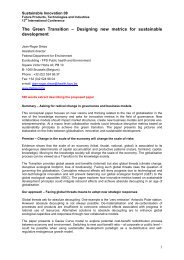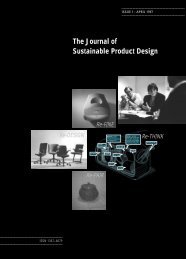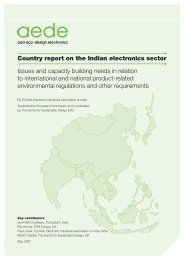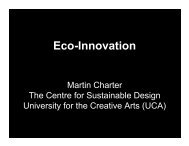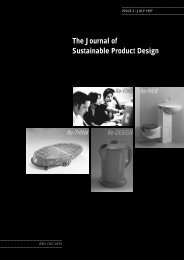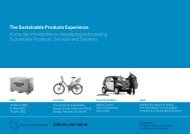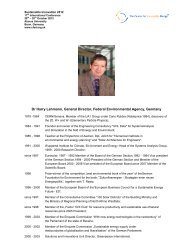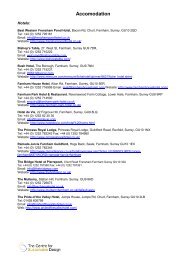acrobat JSPD 8 - The Centre for Sustainable Design
acrobat JSPD 8 - The Centre for Sustainable Design
acrobat JSPD 8 - The Centre for Sustainable Design
You also want an ePaper? Increase the reach of your titles
YUMPU automatically turns print PDFs into web optimized ePapers that Google loves.
variables and variables in the<br />
system environment, and provides<br />
an explicit statement of cause and<br />
effect relationships within a<br />
system and between the system<br />
and its environment. Variables are<br />
in ovals and the connecting<br />
arrows link them together. It<br />
allows the analysis of complex<br />
causes and effects in sequences<br />
that start from a key variable.<br />
<strong>The</strong> diagram can be read starting<br />
at the SPD box (top left of page<br />
34). <strong>The</strong> implementation of SPD<br />
increases the possibilities of<br />
accessing new market channels<br />
and increasing prices by improving<br />
products’ quality and design.<br />
<strong>The</strong> resulting increment in the<br />
product price (reducing the<br />
production costs by improving the<br />
production organisation and technology)<br />
increases the profit<br />
margins which at the same time<br />
increase the investment capacities<br />
of the artisans 2 and the possibility<br />
of carrying out SPD activities. <strong>The</strong><br />
process tends to be economically<br />
self-sufficient by increasing the<br />
artisans’ opportunities to pay <strong>for</strong><br />
SPD activities. Moreover, a<br />
continuous increment in profit<br />
margins can in the long run<br />
increase the ‘quality of life’ of the<br />
artisans by allowing them to have<br />
access to better housing and<br />
services, and by increasing their<br />
access to education. Education<br />
together with the increment in<br />
investment capacities improves<br />
the possibilities of enhancing the<br />
capacity to preserve the local<br />
natural resources by improving<br />
their understanding of the environment<br />
and in many cases going<br />
back to local traditions of <strong>for</strong>est<br />
use and management. <strong>The</strong> incremental<br />
improvement of the<br />
communities’ conservation capacity<br />
together with the implementation<br />
of product development<br />
activities reduce the environmental<br />
impact of the small enterprises<br />
which has a direct effect in<br />
improving the <strong>for</strong>est quality. 3<br />
Figure 5 (page 36) underlines the<br />
impact of product development in<br />
social, economic and environmental<br />
terms. <strong>The</strong> economic<br />
elements are represented by the<br />
product price, the market, the<br />
profit margins and the investment<br />
capacity. <strong>The</strong> social aspects are<br />
represented by two variables, a<br />
very general one of ‘quality of<br />
life' and the access to education.<br />
Finally the environmental aspects<br />
are represented by the conservation<br />
capacity, the environmental<br />
impact of small enterprise<br />
production and the <strong>for</strong>est quality.<br />
<strong>The</strong> SPD process presented in<br />
Figure 4 (page 34) cannot grow<br />
<strong>for</strong>ever and it is limited by the<br />
production volume of small<br />
enterprises which is determined<br />
by the sustainable production<br />
potential of the local <strong>for</strong>ests. <strong>The</strong><br />
local production volume of small<br />
enterprises should not be larger<br />
than the sustainable <strong>for</strong>est potential.<br />
If the production of small<br />
enterprises increases to a level<br />
which requires more timber than<br />
the sustainable potential of local<br />
<strong>for</strong>ests, the process will be<br />
reversed. However, this final<br />
scenario should be avoided by<br />
sustainable <strong>for</strong>est management<br />
and product certification which<br />
should limit production volume.<br />
Conclusions<br />
Most people in developing countries<br />
depend on small enterprises<br />
JANUARY 1999 · THE JOURNAL OF SUSTAINABLE PRODUCT DESIGN<br />
ANALYSIS<br />
Education<br />
together with<br />
the increment<br />
in investment<br />
capacities<br />
improves the<br />
possibilities of<br />
enhancing the<br />
capacity to<br />
preserve the<br />
local natural<br />
resources by<br />
improving their<br />
understanding<br />
of the environment<br />
and in<br />
many cases<br />
going back to<br />
local traditions<br />
of <strong>for</strong>est<br />
use and<br />
management.<br />
37



